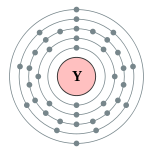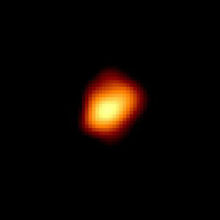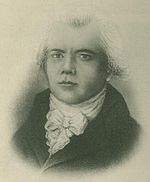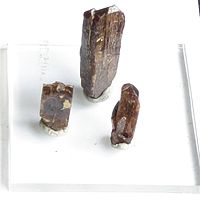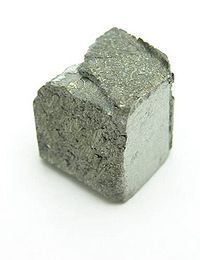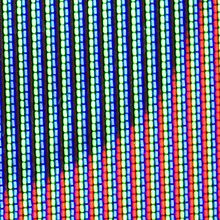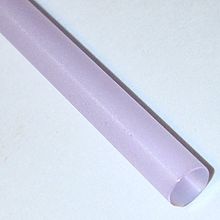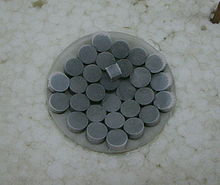
Yttrium
Background Information
Arranging a Wikipedia selection for schools in the developing world without internet was an initiative by SOS Children. Click here for more information on SOS Children.
| Yttrium | |||||||||||||||||||||||||||||||||||||||||||||||||
|---|---|---|---|---|---|---|---|---|---|---|---|---|---|---|---|---|---|---|---|---|---|---|---|---|---|---|---|---|---|---|---|---|---|---|---|---|---|---|---|---|---|---|---|---|---|---|---|---|---|
|
39Y
|
|||||||||||||||||||||||||||||||||||||||||||||||||
|
|||||||||||||||||||||||||||||||||||||||||||||||||
| Appearance | |||||||||||||||||||||||||||||||||||||||||||||||||
silvery white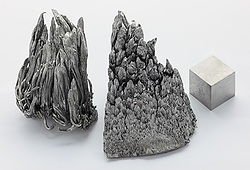 |
|||||||||||||||||||||||||||||||||||||||||||||||||
| General properties | |||||||||||||||||||||||||||||||||||||||||||||||||
| Name, symbol, number | yttrium, Y, 39 | ||||||||||||||||||||||||||||||||||||||||||||||||
| Pronunciation | / ˈ ɪ t r i ə m / IT-ree-əm | ||||||||||||||||||||||||||||||||||||||||||||||||
| Metallic category | transition metal | ||||||||||||||||||||||||||||||||||||||||||||||||
| Group, period, block | 3, 5, d | ||||||||||||||||||||||||||||||||||||||||||||||||
| Standard atomic weight | 88.90585 | ||||||||||||||||||||||||||||||||||||||||||||||||
| Electron configuration | [Kr] 4d1 5s2 2, 8, 18, 9, 2 |
||||||||||||||||||||||||||||||||||||||||||||||||
| History | |||||||||||||||||||||||||||||||||||||||||||||||||
| Discovery | Johan Gadolin (1794) | ||||||||||||||||||||||||||||||||||||||||||||||||
| First isolation | Carl Gustav Mosander (1840) | ||||||||||||||||||||||||||||||||||||||||||||||||
| Physical properties | |||||||||||||||||||||||||||||||||||||||||||||||||
| Phase | solid | ||||||||||||||||||||||||||||||||||||||||||||||||
| Density (near r.t.) | 4.472 g·cm−3 | ||||||||||||||||||||||||||||||||||||||||||||||||
| Liquid density at m.p. | 4.24 g·cm−3 | ||||||||||||||||||||||||||||||||||||||||||||||||
| Melting point | 1799 K, 1526 °C, 2779 °F | ||||||||||||||||||||||||||||||||||||||||||||||||
| Boiling point | 3609 K, 3336 °C, 6037 °F | ||||||||||||||||||||||||||||||||||||||||||||||||
| Heat of fusion | 11.42 kJ·mol−1 | ||||||||||||||||||||||||||||||||||||||||||||||||
| Heat of vaporization | 365 kJ·mol−1 | ||||||||||||||||||||||||||||||||||||||||||||||||
| Molar heat capacity | 26.53 J·mol−1·K−1 | ||||||||||||||||||||||||||||||||||||||||||||||||
| Vapor pressure | |||||||||||||||||||||||||||||||||||||||||||||||||
|
|||||||||||||||||||||||||||||||||||||||||||||||||
| Atomic properties | |||||||||||||||||||||||||||||||||||||||||||||||||
| Oxidation states | 3, 2, 1 (weakly basic oxide) | ||||||||||||||||||||||||||||||||||||||||||||||||
| Electronegativity | 1.22 (Pauling scale) | ||||||||||||||||||||||||||||||||||||||||||||||||
| Ionization energies | 1st: 600 kJ·mol−1 | ||||||||||||||||||||||||||||||||||||||||||||||||
| 2nd: 1180 kJ·mol−1 | |||||||||||||||||||||||||||||||||||||||||||||||||
| 3rd: 1980 kJ·mol−1 | |||||||||||||||||||||||||||||||||||||||||||||||||
| Atomic radius | 180 pm | ||||||||||||||||||||||||||||||||||||||||||||||||
| Covalent radius | 190±7 pm | ||||||||||||||||||||||||||||||||||||||||||||||||
| Miscellanea | |||||||||||||||||||||||||||||||||||||||||||||||||
| Crystal structure | hexagonal close-packed | ||||||||||||||||||||||||||||||||||||||||||||||||
| Magnetic ordering | paramagnetic | ||||||||||||||||||||||||||||||||||||||||||||||||
| Electrical resistivity | ( r.t.) (α, poly) 596 nΩ·m | ||||||||||||||||||||||||||||||||||||||||||||||||
| Thermal conductivity | 17.2 W·m−1·K−1 | ||||||||||||||||||||||||||||||||||||||||||||||||
| Thermal expansion | ( r.t.) (α, poly) 10.6 µm/(m·K) |
||||||||||||||||||||||||||||||||||||||||||||||||
| Speed of sound (thin rod) | (20 °C) 3300 m·s−1 | ||||||||||||||||||||||||||||||||||||||||||||||||
| Young's modulus | 63.5 GPa | ||||||||||||||||||||||||||||||||||||||||||||||||
| Shear modulus | 25.6 GPa | ||||||||||||||||||||||||||||||||||||||||||||||||
| Bulk modulus | 41.2 GPa | ||||||||||||||||||||||||||||||||||||||||||||||||
| Poisson ratio | 0.243 | ||||||||||||||||||||||||||||||||||||||||||||||||
| Brinell hardness | 589 MPa | ||||||||||||||||||||||||||||||||||||||||||||||||
| CAS registry number | 7440-65-5 | ||||||||||||||||||||||||||||||||||||||||||||||||
| Most stable isotopes | |||||||||||||||||||||||||||||||||||||||||||||||||
| Main article: Isotopes of yttrium | |||||||||||||||||||||||||||||||||||||||||||||||||
|
|||||||||||||||||||||||||||||||||||||||||||||||||
Yttrium is a chemical element with symbol Y and atomic number 39. It is a silvery-metallic transition metal chemically similar to the lanthanides and it has often been classified as a " rare earth element". Yttrium is almost always found combined with the lanthanides in rare earth minerals and is never found in nature as a free element. Its only stable isotope, 89Y, is also its only naturally occurring isotope.
In 1787, Carl Axel Arrhenius found a new mineral near Ytterby in Sweden and named it ytterbite, after the village. Johan Gadolin discovered yttrium's oxide in Arrhenius' sample in 1789, and Anders Gustaf Ekeberg named the new oxide yttria. Elemental yttrium was first isolated in 1828 by Friedrich Wöhler.
The most important use of yttrium is in making phosphors, such as the red ones used in television set cathode ray tube (CRT) displays and in LEDs. Other uses include the production of electrodes, electrolytes, electronic filters, lasers and superconductors; various medical applications; and as traces in various materials to enhance their properties. Yttrium has no known biological role, and exposure to yttrium compounds can cause lung disease in humans.
Characteristics
Properties
Yttrium is a soft, silver-metallic, lustrous and highly crystalline transition metal in group 3. As expected by periodic trends, it is less electronegative than its predecessor in the group, scandium, more electronegative than its successor in the group, lanthanum, and less electronegative than the next member of period 5, zirconium. Yttrium is the first d-block element in the fifth period.
The pure element is relatively stable in air in bulk form, due to passivation resulting from the formation of a protective oxide (Y2O3) film on its surface. This film can reach a thickness of 10 µm when yttrium is heated to 750 °C in water vapor. When finely divided, however, yttrium is very unstable in air; shavings or turnings of the metal can ignite in air at temperatures exceeding 400 °C. Yttrium nitride (YN) is formed when the metal is heated to 1000 °C in nitrogen.
Similarity to the lanthanides
The similarities of yttrium to the lanthanides are so strong that the element has historically been grouped with them as a rare earth element, and is always found in nature together with them in rare earth minerals.
Chemically, yttrium resembles these elements more closely than its neighbour in the periodic table, scandium, and if its physical properties were plotted against atomic number then it would have an apparent number of 64.5 to 67.5, placing it between the lanthanides gadolinium and erbium.
It often also falls in the same range for reaction order, resembling terbium and dysprosium in its chemical reactivity. Yttrium is so close in size to the so-called 'Yttrium group' of heavy lanthanide ions that in solution, it behaves as if it were one of them. Even though the lanthanides are one row farther down the periodic table than yttrium, the similarity in atomic radius may be attributed to the lanthanide contraction.
One of the few notable differences between the chemistry of yttrium and that of the lanthanides is that yttrium is almost exclusively trivalent, whereas about half of the lanthanides can have valences other than three.
Compounds and reactions
As a trivalent transition metal, yttrium forms various inorganic compounds, generally in the oxidation state of +3, by giving up all three of its valence electrons. A good example is yttrium(III) oxide (Y2O3), also known as yttria, a six- coordinate white solid.
Yttrium forms a water-insoluble fluoride, hydroxide, and oxalate, but its bromide, chloride, iodide, nitrate and sulfate are all soluble in water. The Y3+ ion is colorless in solution because of the absence of electrons in the d and f electron shells.
Water readily reacts with yttrium and its compounds to form Y2O3. Concentrated nitric and hydrofluoric acids do not rapidly attack yttrium, but other strong acids do.
With halogens, yttrium forms trihalides such as yttrium(III) fluoride (YF3), yttrium(III) chloride (YCl3), and yttrium(III) bromide (YBr3) at temperatures above roughly 200 °C. Similarly, carbon, phosphorus, selenium, silicon and sulfur all form binary compounds with yttrium at elevated temperatures.
Organoyttrium chemistry is the study of compounds containing carbon–yttrium bonds. A few of these are known to have yttrium in the oxidation state 0. (The +2 state has been observed in chloride melts, and +1 in oxide clusters in the gas phase.) Some trimerization reactions were observed by using organoyttrium compounds as catalysts. These compounds use YCl3 as a starting material, which in turn is obtained from Y2O3 and concentrated hydrochloric acid and ammonium chloride.
Hapticity is how a group of contiguous atoms of a ligand are coordinated to a central atom; it is indicated by the Greek character eta, η. Yttrium complexes were the first examples of complexes where carboranyl ligands were bound to a d0-metal centre through a η7-hapticity. Vaporization of the graphite intercalation compounds graphite–Y or graphite–Y2O3 leads to the formation of endohedral fullerenes such as Y@C82. Electron spin resonance studies indicated the formation of Y3+ and (C82)3− ion pairs. The carbides Y3C, Y2C, and YC2 can each hydrolyze to form hydrocarbons.
Nucleosynthesis and isotopes
Yttrium in the Solar System was created through stellar nucleosynthesis, mostly by the s-process (≈72%), but also by the r-process (≈28%). The r-process consists of rapid neutron capture of lighter elements during supernova explosions. The s-process is a slow neutron capture of lighter elements inside pulsating red giant stars.
Yttrium isotopes are among the most common products of the nuclear fission of uranium occurring in nuclear explosions and nuclear reactors. In terms of nuclear waste management, the most important isotopes of yttrium are 91Y and 90Y, with half-lives of 58.51 days and 64 hours, respectively. Though 90Y has the short half-life, it exists in secular equilibrium with its long-lived parent isotope, strontium-90 (90Sr) with a half-life of 29 years.
All group three elements have an odd atomic number, and therefore they have few stable isotopes. Scandium has one stable isotope, and yttrium itself has only one stable isotope, 89Y, which is also its only naturally occurring one. However, the lanthanide rare earths contain elements of even atomic number and many stable isotopes. Yttrium-89 is thought to be more abundant than it otherwise would be, due in part to the s-process, which allows enough time for isotopes created by other processes to decay by electron emission (neutron → proton). Such a slow process tends to favour isotopes with atomic mass numbers (A = protons + neutrons) around 90, 138 and 208, which have unusually stable atomic nuclei with 50, 82, and 126 neutrons, respectively. 89Y has a mass number close to 90 and has 50 neutrons in its nucleus.
At least 32 synthetic isotopes of yttrium have been observed, and these range in atomic mass number from 76 to 108. The least stable of these is 106Y with a half-life of >150 ns (76Y has a half-life of >200 ns) and the most stable is 88Y with a half-life of 106.626 days. Besides the isotopes 91Y, 87Y, and 90Y, with half-lives of 58.51 days, 79.8 hours, and 64 hours, respectively, all the other isotopes have half-lives of less than a day and most of those have half-lives of less than an hour.
Yttrium isotopes with mass numbers at or below 88 decay primarily by positron emission (proton → neutron) to form strontium (Z = 38) isotopes. Yttrium isotopes with mass numbers at or above 90 decay primarily by electron emission (neutron → proton) to form zirconium (Z = 40) isotopes. Isotopes with mass numbers at or above 97 are also known to have minor decay paths of β− delayed neutron emission.
Yttrium has at least 20 metastable or excited isomers ranging in mass number from 78 to 102. Multiple excitation states have been observed for 80Y and 97Y. While most of yttrium's isomers are expected to be less stable than their ground state, 78mY, 84mY, 85mY, 96mY, 98m1Y, 100mY, and 102mY have longer half-lives than their ground states, as these isomers decay by beta decay rather than isomeric transition.
History
In 1787, army lieutenant and part-time chemist Carl Axel Arrhenius found a heavy black rock in an old quarry near the Swedish village of Ytterby (now part of the Stockholm Archipelago). Thinking that it was an unknown mineral containing the newly discovered element tungsten, he named it ytterbite and sent samples to various chemists for further analysis.
Johan Gadolin at the University of Åbo identified a new oxide or " earth" in Arrhenius' sample in 1789, and published his completed analysis in 1794. Anders Gustaf Ekeberg confirmed this in 1797 and named the new oxide yttria. In the decades after Antoine Lavoisier developed the first modern definition of chemical elements, it was believed that earths could be reduced to their elements, meaning that the discovery of a new earth was equivalent to the discovery of the element within, which in this case would have been yttrium.
In 1843, Carl Gustaf Mosander found that samples of yttria contained three oxides: white yttrium oxide (yttria), yellow terbium oxide (confusingly, this was called 'erbia' at the time) and rose-colored erbium oxide (called 'terbia' at the time). A fourth oxide, ytterbium oxide, was isolated in 1878 by Jean Charles Galissard de Marignac. New elements would later be isolated from each of those oxides, and each element was named, in some fashion, after Ytterby, the village near the quarry where they were found (see ytterbium, terbium, and erbium). In the following decades, seven other new metals were discovered in "Gadolin's yttria". Since yttria was a mineral after all and not an oxide, Martin Heinrich Klaproth renamed it gadolinite in honour of Gadolin.
Yttrium metal was first isolated in 1828 when Friedrich Wöhler heated anhydrous yttrium(III) chloride with potassium:
- YCl3 + 3 K → 3 KCl + Y
Until the early 1920s, the chemical symbol Yt was used for the element, after which Y came into common use.
In 1987, yttrium barium copper oxide was found to achieve high-temperature superconductivity. It was only the second material known to exhibit this property, and it was the first known material to achieve superconductivity above the (economically important) boiling point of nitrogen.
Occurrence
Abundance
Yttrium is found in most rare earth minerals, as well as some uranium ores, but is never found in nature as a free element. About 31 ppm of the Earth's crust is yttrium, making it the 28th most abundant element there, and 400 times more common than silver. Yttrium is found in soil in concentrations between 10 and 150 ppm (dry weight average of 23 ppm) and in sea water at 9 ppt. Lunar rock samples collected during the American Apollo Project have a relatively high content of yttrium.
Yttrium has no known biological role, though it is found in most, if not all, organisms and tends to concentrate in the liver, kidney, spleen, lungs, and bones of humans. There is normally as little as 0.5 milligrams found within the entire human body; human breast milk contains 4 ppm. Yttrium can be found in edible plants in concentrations between 20 ppm and 100 ppm (fresh weight), with cabbage having the largest amount. With up to 700 ppm, the seeds of woody plants have the highest known concentrations.
Production
The chemical similarity of yttrium with the lanthanides leads it to being enriched by the same processes and ends up in ores containing lanthanides, forming rare earth minerals. A slight separation is recognized between the light (LREE) and the heavy rare earth elements (HREE) but this separation is never complete. Yttrium is concentrated in the HREE group by virtue of its ionic size even though it has a lower atomic mass.
There are four main sources for REEs:
- Carbonate and fluoride containing ores such as the LREE bastnäsite ([(Ce, La, etc.)(CO3)F]) contain an average of 0.1% of yttrium compared to the 99.9% for the 16 other REEs. The main source for bastnäsite from the 1960s to the 1990s was the Mountain Pass rare earth mine in California, making the United States the largest producer of REEs during that period.
- Monazite ([(Ce, La, etc.) PO4]), which is mostly phosphate, is a placer deposit of sand that is created by the transportation and gravitational separation of eroded granite. Monazite as a LREE ore contains 2% (or 3%) of yttrium. The largest deposits were found in India and Brazil in the early 20th century, making these two countries the largest producers of yttrium in the first half of that century.
- Xenotime, a REE phosphate, is the main HREE ore containing up to 60% of yttrium as yttrium phosphate (YPO4). The largest mine for this mineral is the Bayan Obo deposit in China, making China the largest exporter for HREE since the closure of the Mountain Pass mine in the 1990s.
- Ion absorption clays or Lognan clays are the weathering products of granite and contain only 1% of REEs. The final ore concentrate can contain up to 8% of yttrium. Ion absorption clays are mostly mined in southern China. Yttrium is also found in samarskite and fergusonite.
One method to obtain pure yttrium from the mixed oxide ores is to dissolve the oxide in sulfuric acid and fractionate it by ion exchange chromatography. With the addition of oxalic acid, the yttrium oxalate precipitates. The oxalate is converted into the oxide by heating under oxygen. By reacting the resulting yttrium oxide with hydrogen fluoride, yttrium fluoride is obtained. Using quaternary ammonium salts as extractants, yttrium prefers to remain in the aqueous phase: when the counter-ion is nitrate, the light lanthanides are removed, but when the counter-ion is thiocyanate, the heavy lanthanides are removed. Yttrium salts of 99.999% purity are obtained. In the usual situation, where yttrium is two-thirds of a heavy-lanthanide mixture, there is an advantage to getting it out of the system as quickly as possible, to ease the separation of the remaining elements.
Annual world production of yttrium oxide had reached 600 tonnes by 2001, with reserves estimated at 9 million tonnes. Only a few tonnes of yttrium metal are produced each year by reducing yttrium fluoride to a metal sponge with calcium magnesium alloy. The temperature of an arc furnace of above 1,600 °C is sufficient to melt the yttrium.
Applications
Consumer
Yttria (Y2O3) can serve as host lattice for doping with Eu3+ cations as well as reactant to gain doped yttrium orthovanadate Y VO4:Eu3+ or yttrium oxide sulfide Y2O2S:Eu3+ phosphors that give the red colour in color television picture tubes, though the red colour itself is actually emitted from the europium while the yttrium collects energy from the electron gun and passes it to the phosphor. Yttrium compounds can serve as host lattices for doping with different lanthanide cations. Besides Eu3+ also Tb3+ can be used as a doping agent leading to green luminescence. Yttria is also used as a sintering additive in the production of porous silicon nitride and as a common starting material for both material science and for producing other compounds of yttrium.
Yttrium compounds are used as a catalyst for ethylene polymerization. As a metal, it is used on the electrodes of some high-performance spark plugs. Yttrium is also used in the manufacturing of gas mantles for propane lanterns as a replacement for thorium, which is radioactive.
Developing uses include yttrium-stabilized zirconia in particular as a solid electrolyte and as an oxygen sensor in automobile exhaust systems.
Garnets
Yttrium is used in the production of a large variety of synthetic garnets, and yttria is used to make yttrium iron garnets (Y3Fe5O12 or YIG), which are very effective microwave filters. Yttrium, iron, aluminium, and gadolinium garnets (e.g. Y3(Fe,Al)5O12 and Y3(Fe,Ga)5O12) have important magnetic properties. YIG is also very efficient as an acoustic energy transmitter and transducer. Yttrium aluminium garnet (Y3Al5O12 or YAG) has a hardness of 8.5 and is also used as a gemstone in jewelry (simulated diamond). Cerium-doped yttrium aluminium garnet (YAG:Ce) crystals are used as phosphors to make white LEDs.
YAG, yttria, yttrium lithium fluoride (LiYF4), and yttrium orthovanadate (YVO4) are used in combination with dopants such as neodymium, erbium, ytterbium in near- infrared lasers. YAG lasers have the ability to operate at high power and are used for drilling into and cutting metal. The single crystals of doped YAG are normally produced by the Czochralski process.
Material enhancer
Small amounts of yttrium (0.1 to 0.2%) have been used to reduce the grain sizes of chromium, molybdenum, titanium, and zirconium. It is also used to increase the strength of aluminium and magnesium alloys. The addition of yttrium to alloys generally improves workability, adds resistance to high-temperature recrystallization and significantly enhances resistance to high-temperature oxidation (see graphite nodule discussion below).
Yttrium can be used to deoxidize vanadium and other non-ferrous metals. Yttria is used to stabilize the cubic form of zirconia for use in jewelry.
Yttrium has been studied for possible use as a nodulizer in making nodular cast iron, which has increased ductility (the graphite forms compact nodules instead of flakes to form nodular cast iron). Yttrium oxide can also be used in ceramic and glass formulas, since it has a high melting point and imparts shock resistance and low thermal expansion characteristics. It is therefore used in camera lenses.
Medical
The radioactive isotope yttrium-90 is used in drugs such as Yttrium Y 90-DOTA-tyr3-octreotide and Yttrium Y 90 ibritumomab tiuxetan for the treatment of various cancers, including lymphoma, leukemia, ovarian, colorectal, pancreatic, and bone cancers. It works by adhering to monoclonal antibodies, which in turn bind to cancer cells and kill them via intense β-radiation from the yttrium-90 (see Monoclonal antibody therapy).
Needles made of yttrium-90, which can cut more precisely than scalpels, have been used to sever pain-transmitting nerves in the spinal cord, and yttrium-90 is also used to carry out radionuclide synovectomy in the treatment of inflamed joints, especially knees, in sufferers of conditions such as rheumatoid arthritis.
A neodymium-doped yttrium-aluminium-garnet laser has been used in an experimental, robot-assisted radical prostatectomy in canines in an attempt to reduce collateral nerve and tissue damage, whilst the erbium-doped ones are starting to be used in cosmetic skin resurfacing.
Superconductors
Yttrium was used in the yttrium barium copper oxide (YBa2Cu3O7, aka 'YBCO' or '1-2-3') superconductor developed at the University of Alabama and the University of Houston in 1987. This superconductor operated at 93 K, notable because this is above liquid nitrogen's boiling point (77.1 K). As the price of liquid nitrogen is lower than that of liquid helium, which must be used for the metallic superconductors, the operating costs would decrease.
The actual superconducting material is often written as YBa2Cu3O7–d, where d must be less than 0.7 for the material to superconduct. The reason for this is still not clear, but it is known that the vacancies occur only in certain places in the crystal, the copper oxide planes and chains, giving rise to a peculiar oxidation state of the copper atoms, which somehow leads to the superconducting behaviour.
The theory of low temperature superconductivity has been well understood since the BCS theory was put forward in 1957. It is based on a peculiarity of the interaction between two electrons in a crystal lattice. However, the BCS theory does not explain high temperature superconductivity, and its precise mechanism is still a mystery. What is known is that the composition of the copper-oxide materials must be precisely controlled if superconductivity is to occur.
The created material was a black and green, multi-crystal, multi-phase mineral. Researchers are studying a class of materials known as perovskites that are alternative mixtures of these elements, hoping to eventually develop a practical high-temperature superconductor.
Precautions
Water soluble compounds of yttrium are considered mildly toxic, while its insoluble compounds are non-toxic. In experiments on animals, yttrium and its compounds caused lung and liver damage, though toxicity varies with different yttrium compounds. In rats, inhalation of yttrium citrate caused pulmonary edema and dyspnea, while inhalation of yttrium chloride caused liver edema, pleural effusions, and pulmonary hyperemia.
Exposure to yttrium compounds in humans may cause lung disease. Workers exposed to airborne yttrium europium vanadate dust experienced mild eye, skin, and upper respiratory tract irritation—though this may have been caused by the vanadium content rather than the yttrium. Acute exposure to yttrium compounds can cause shortness of breath, coughing, chest pain, and cyanosis. NIOSH recommends a time-weighted average limit of 1 mg/m3 and an IDLH of 500 mg/m3. Yttrium dust is flammable.
